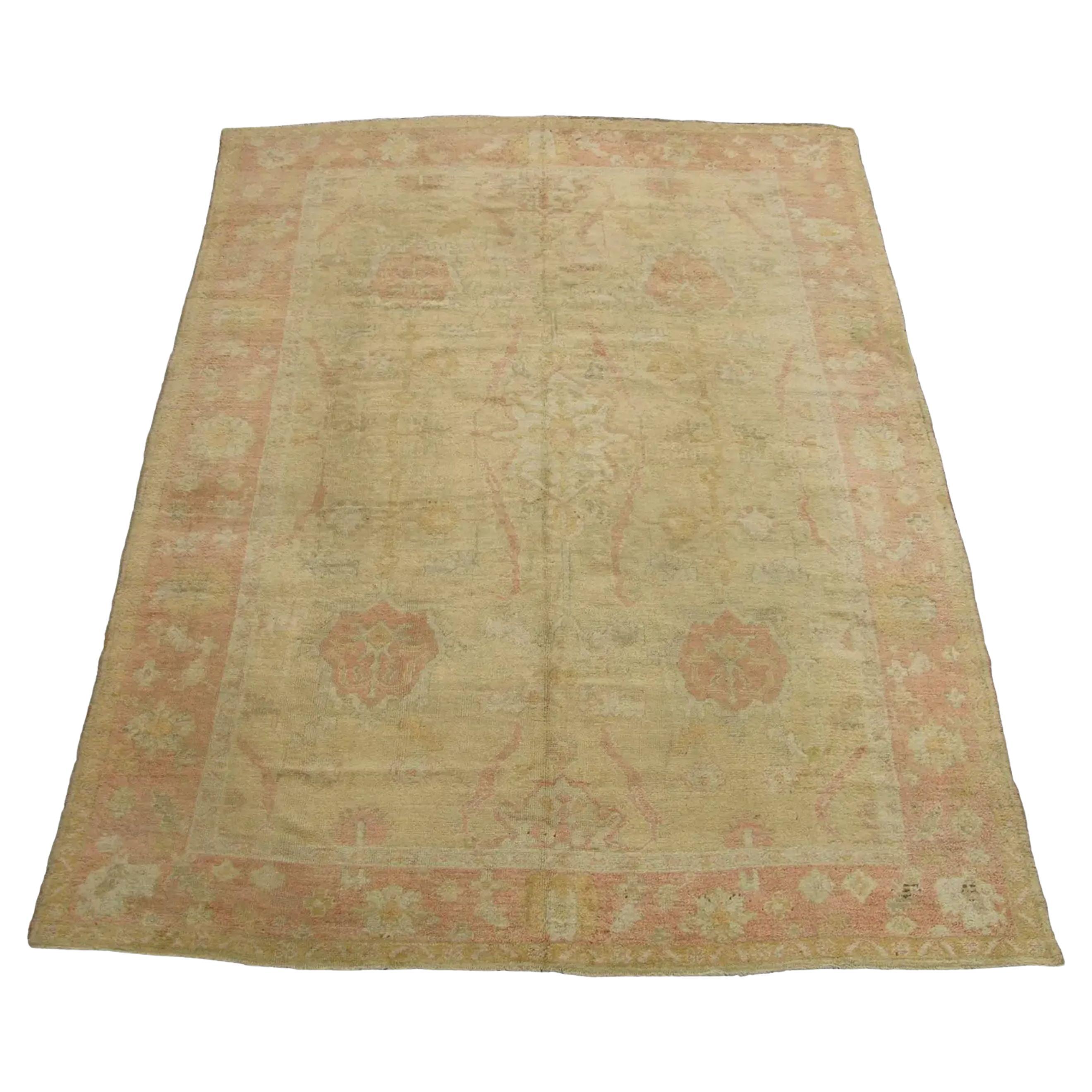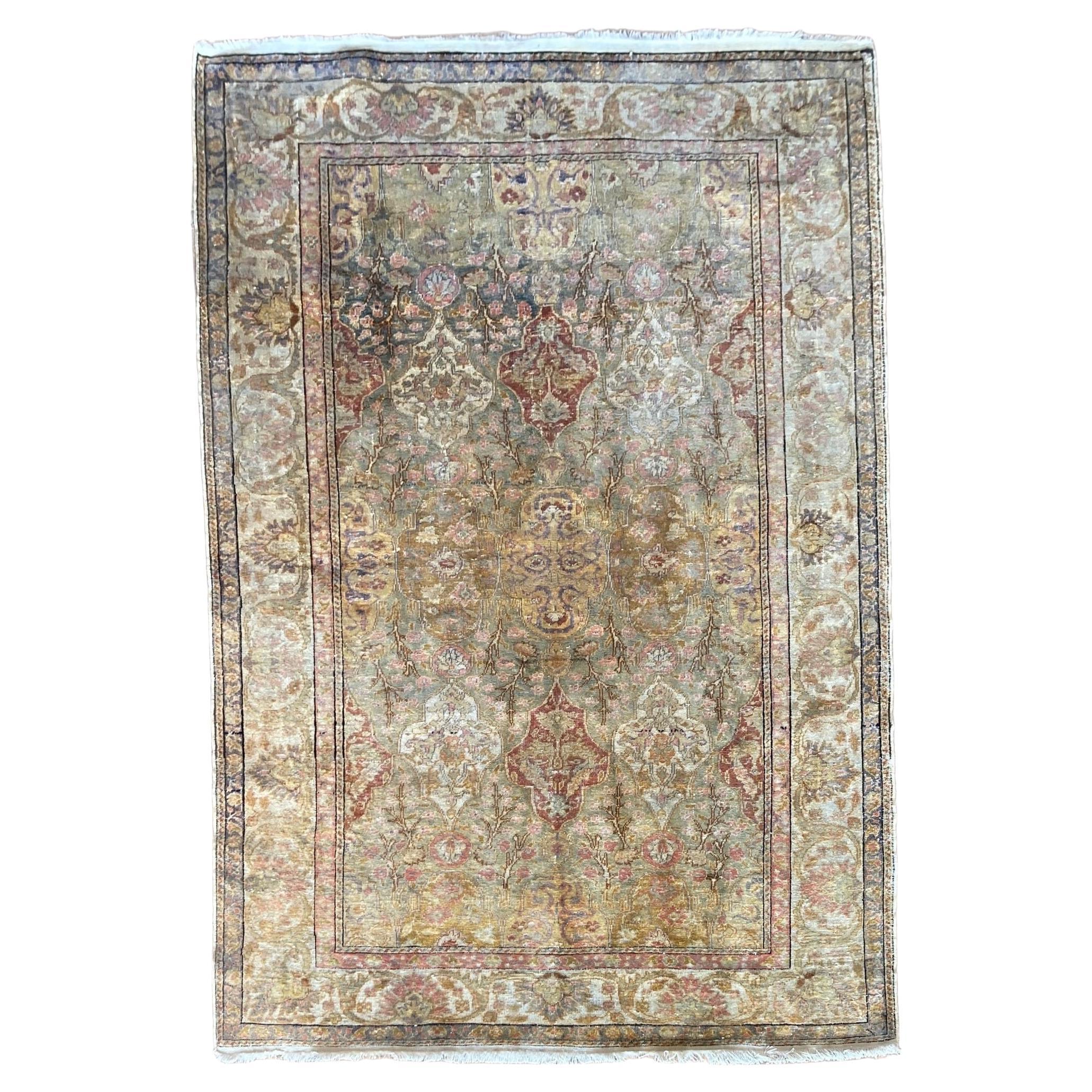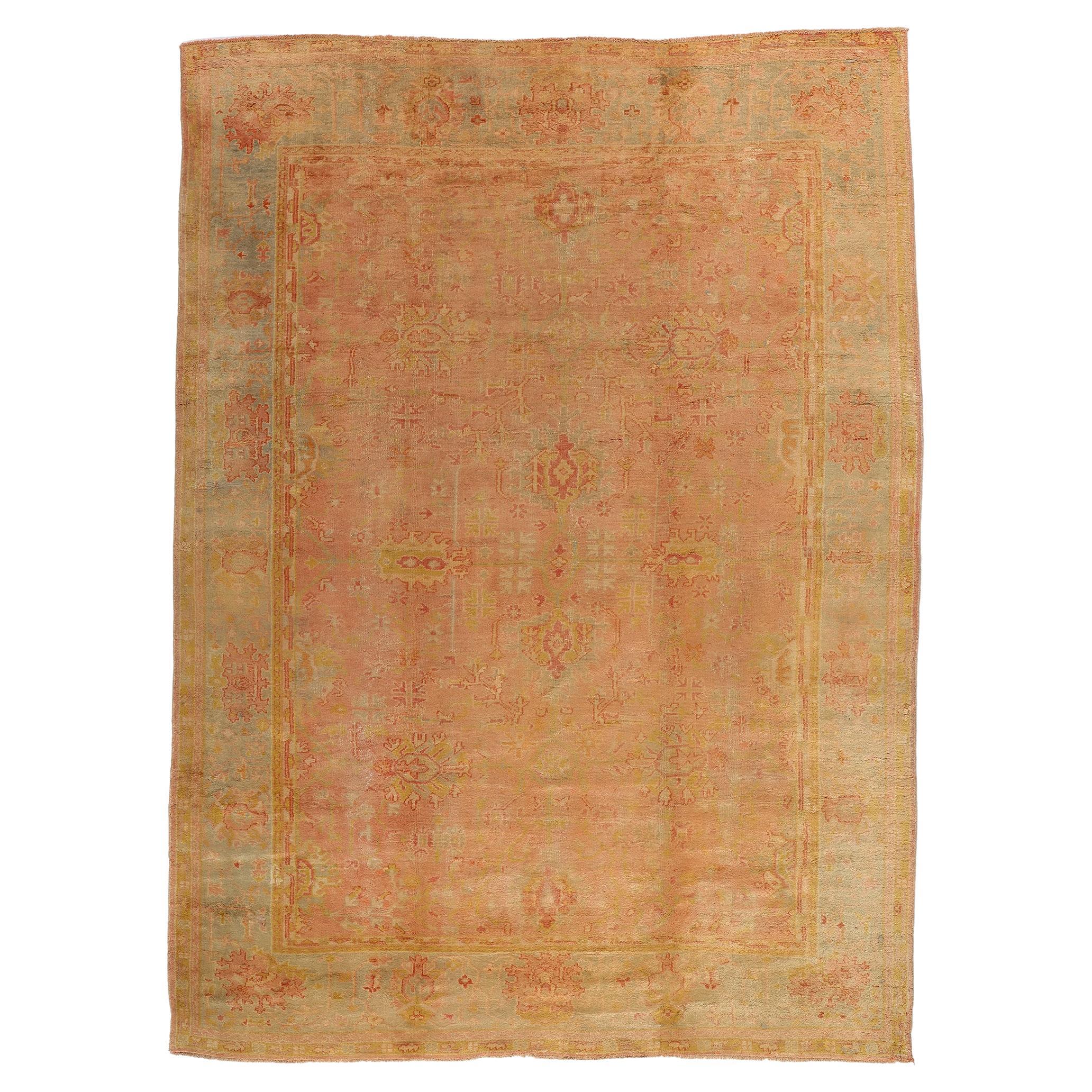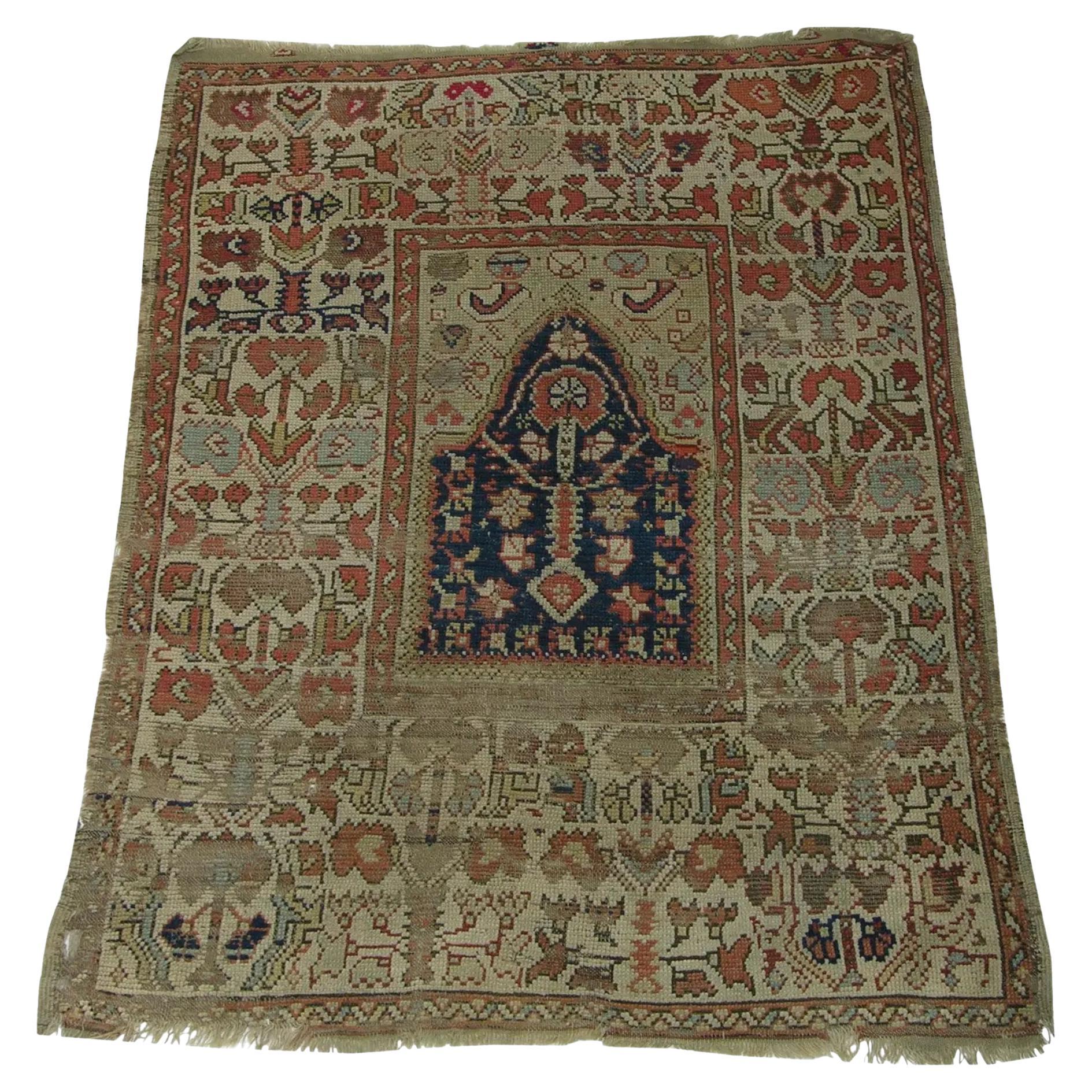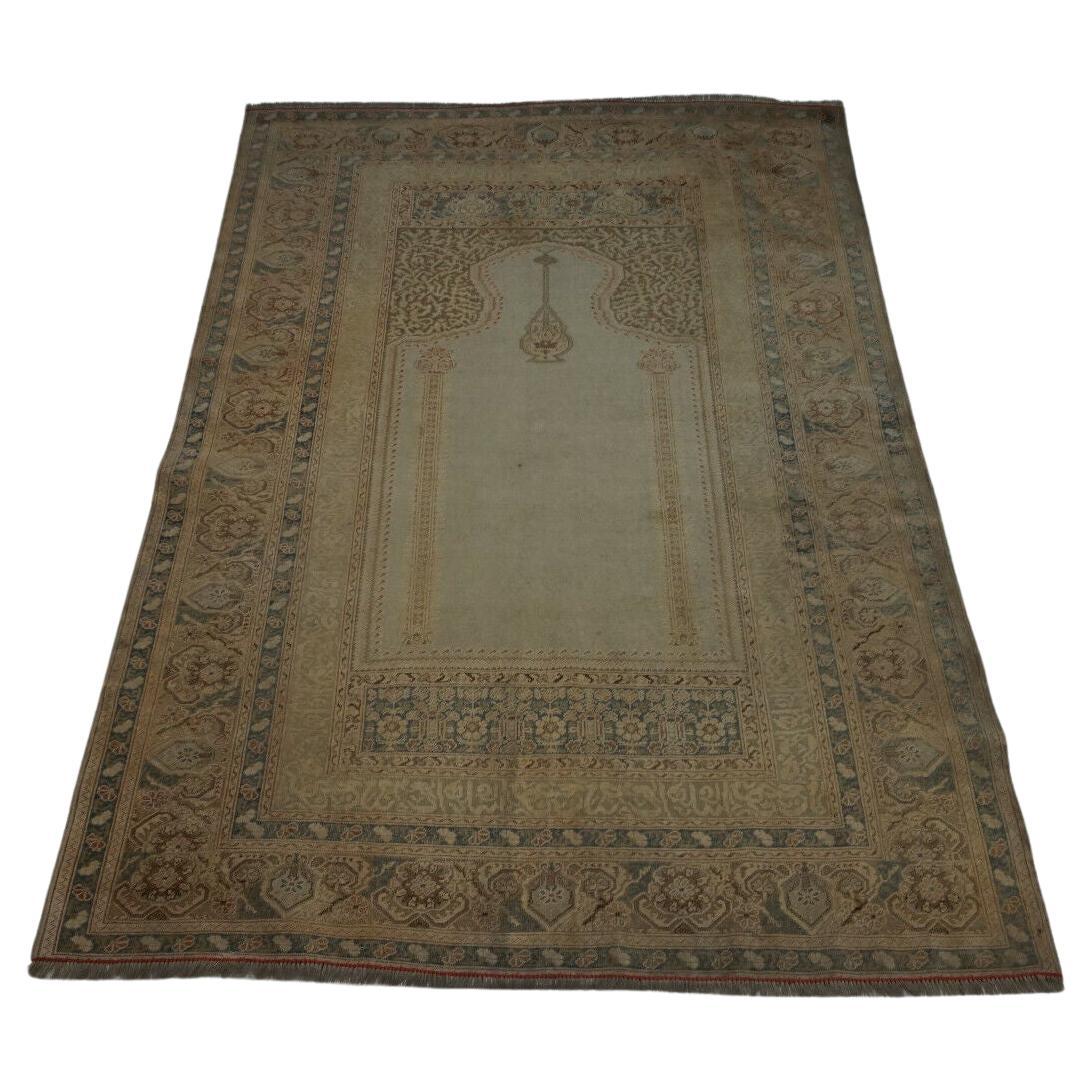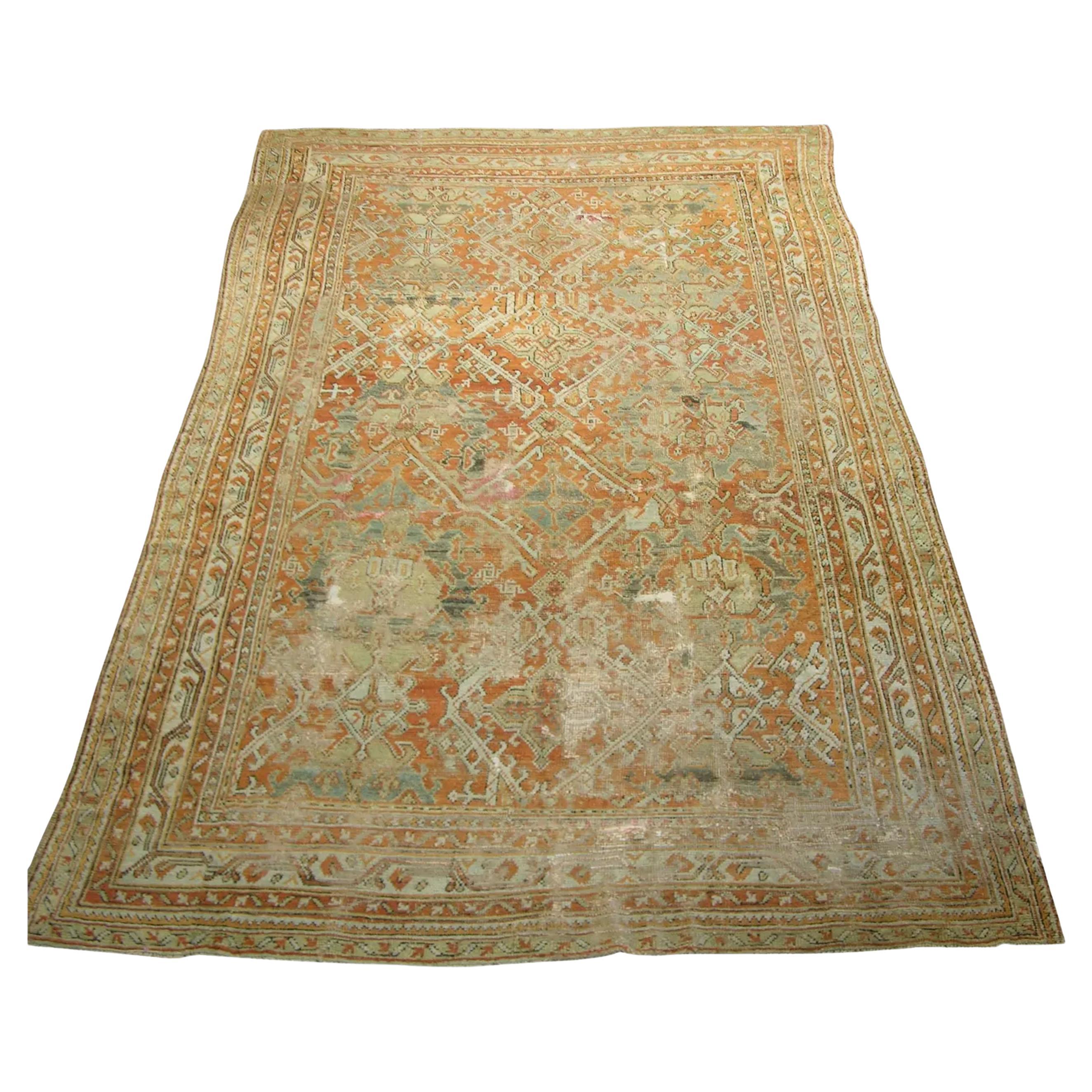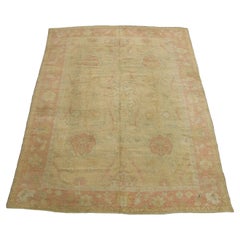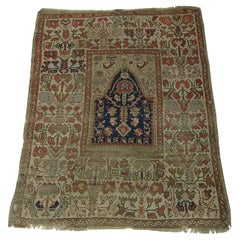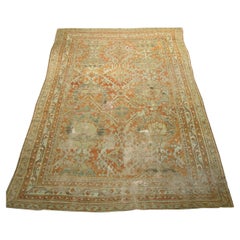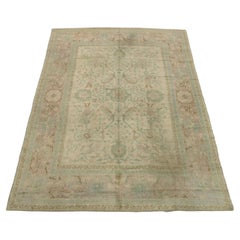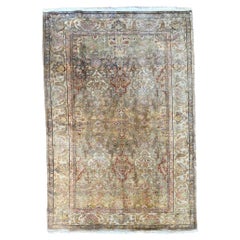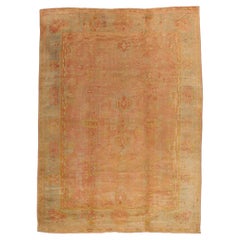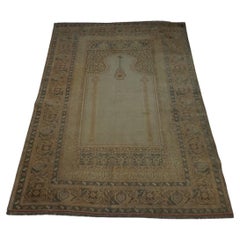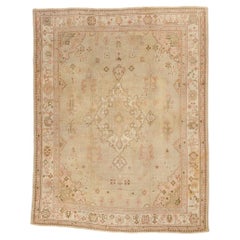Items Similar to 1900s Fine Antique Prayer Turkish Silk Rug - 5'5'' X 3'10''
Want more images or videos?
Request additional images or videos from the seller
1 of 5
1900s Fine Antique Prayer Turkish Silk Rug - 5'5'' X 3'10''
$6,450
£4,931.37
€5,679.94
CA$9,038.43
A$10,090.55
CHF 5,287.30
MX$123,518.29
NOK 67,148.75
SEK 63,312.74
DKK 42,389.98
Shipping
Retrieving quote...The 1stDibs Promise:
Authenticity Guarantee,
Money-Back Guarantee,
24-Hour Cancellation
About the Item
Silk Rugs – Silk Carpets and area rugs are the most luxurious productions of their kind. The silk textile production began in China, although silk rugs are unattested there until the seventeenth century.
Silk textile manufacture was well established in Persia by the Sassanian Period (third to seventh centuries). Consequently, it would have been possible for the Persians of this period or those of Early Islamic times to have adapted silk to rug production. But it is so far unclear whether China or the Islamic Orient initiated the manufacture of silk carpets.
At any rate, the earliest extant of all the antique handmade silk rugs are in fact the handmade Persian silk rugs of the Safavid Period. Eventually rugs with all or part silk construction came to be made in virtually all Oriental rug – producing regions – Persia, Turkey, Turkestan, Tibet, and China. In the finest examples, not only the pile but even the foundation (wefts and warp fringes) are made of silk. Silk rugs are luxurious not only because of the fine texture and the reflective, luminous properties of the pile, but also because of the quality of their color. Silk allows the dyes to achieve a richness and intensity that can never be matched by even the finest wool.
Silk is a magical fiber that is unbelievably thin and astoundingly strong. Even when silk highlights are used to add definition to ornate designs, the complexion of a carpet or textile can change completely. The hand of silk rugs and textiles is rich and sumptuous. These traits are matched by the luminosity of colors when light is reflected by the fiber’s prismatic structure. Silk is lithe yet exceptionally durable. As a commodity, it built the world’s most famous trade route and created immortal legends. Today, silk is still the ultimate luxury fiber. The intrinsic value and beauty of silk is destined to outshine all other natural and synthetic fibers known to man.
- Dimensions:Width: 46 in (116.84 cm)Length: 65 in (165.1 cm)
- Style:Other (In the Style Of)
- Materials and Techniques:
- Place of Origin:
- Period:1900-1909
- Date of Manufacture:1900
- Condition:good condition.
- Seller Location:Los Angeles, US
- Reference Number:Seller: 4015y1stDibs: LU9020235536062
About the Seller
5.0
Platinum Seller
Premium sellers with a 4.7+ rating and 24-hour response times
Established in 1920
1stDibs seller since 2023
63 sales on 1stDibs
Typical response time: <1 hour
- ShippingRetrieving quote...Shipping from: Los Angeles, US
- Return Policy
Authenticity Guarantee
In the unlikely event there’s an issue with an item’s authenticity, contact us within 1 year for a full refund. DetailsMoney-Back Guarantee
If your item is not as described, is damaged in transit, or does not arrive, contact us within 7 days for a full refund. Details24-Hour Cancellation
You have a 24-hour grace period in which to reconsider your purchase, with no questions asked.Vetted Professional Sellers
Our world-class sellers must adhere to strict standards for service and quality, maintaining the integrity of our listings.Price-Match Guarantee
If you find that a seller listed the same item for a lower price elsewhere, we’ll match it.Trusted Global Delivery
Our best-in-class carrier network provides specialized shipping options worldwide, including custom delivery.More From This Seller
View All19th Century Turkish Oushak Rug 13'9" X 10'10"
Located in Los Angeles, US
Antique Turkish Oushak rugs have been woven in Western Turkey since the beginning of the Ottoman period. Historians attributed to them many of the great masterpieces of early Turkish...
Category
Antique 19th Century Turkish Oushak Turkish Rugs
Materials
Wool, Cotton
Early-18th Century Antique Prayer Turkish Rug 4'6'' X 3'3''
Located in Los Angeles, US
Early-18th Century Antique Prayer Turkish Rug 4'6'' X 3'3'', From 1800s, wool on wool foundation super vintage and unique.
Category
Antique Early 18th Century Turkish Tribal Turkish Rugs
Materials
Wool
Early 19th Century 1850 Century Tribal Turkish Oushak Rug
Located in Los Angeles, US
Antique Turkish Oushak rugs have been woven in Western Turkey since the beginning of the Ottoman period. Historians attributed to them many of the great masterpieces of early Turkish...
Category
Antique Mid-19th Century Turkish Oushak Turkish Rugs
Materials
Wool, Cotton
Mid-19th Century Tribal Turkish Oushak Rug 13'1" X 9'4"
Located in Los Angeles, US
Antique Turkish Oushak rugs have been woven in Western Turkey since the beginning of the Ottoman period. Historians attributed to them many of the great masterpieces of early Turkish...
Category
Antique 19th Century Turkish Oushak Turkish Rugs
Materials
Wool, Cotton
Antique Samarkand Rug 1900 -11'5'' X 5'10''
Located in Los Angeles, US
Antique Uzbek Samarkand Rug 11'5'' X 5'10'', tribal and traditional, antique and vintage, wool on cotton foundation
Category
Antique Early 1900s Uzbek Tribal Russian and Scandinavian Rugs
Materials
Wool, Cotton
1900s Mid-19th Century Tribal Turkish Oushak Rug 10'0'' X 6'10''
Located in Los Angeles, US
Antique Turkish Oushak rugs have been woven in Western Turkey since the beginning of the Ottoman period. Historians attributed to them many of the great masterpieces of early Turkish...
Category
Antique Early 1900s Turkish Tribal Turkish Rugs
Materials
Wool
You May Also Like
Vintage Turkish Kayseri Silk Rug 1.65m x 1.16m
Located in St. Albans, GB
A fabulous vintage silk rug, hand woven in Kayseri, central Turkey circa 1960 with an allover shield design in soft pastel tones. Very finely woven in silk on a cotton foundation.
Si...
Category
Vintage 1960s Turkish Turkish Rugs
Materials
Silk
Late 19th Century Turkish Oushak Rug with Traditional Style
Located in Dallas, TX
73159 Late 19th Century Antique Turkish Oushak Rug, 10'01 x 13'09. Steeped in the golden legacy of Anatolian artistry, this exquisite, hand-knotted wool antique Turkish Oushak rug fr...
Category
Antique Late 19th Century Turkish Aesthetic Movement Turkish Rugs
Materials
Wool
Handmade Antique Turkish Transilvania Prayer Rug 4.2' x 6.2', 1880s - 1D65
Located in Bordeaux, FR
Handmade Antique Turkish Transilvania Prayer Rug
Embrace the rich history and cultural heritage with our Handmade Antique Turkish Transilvania Prayer Rug. Dating back to the 1880s, t...
Category
Antique 1880s Turkish Rugs
Materials
Wool
$5,670 Sale Price
20% Off
1900's Antique Turkish Oushak Rug with Traditional Style
Located in Dallas, TX
73571 Antique Turkish Oushak Rug, 10'01 x 13'01. Echoing the hushed splendor of a vanished empire, this enchanting antique Turkish Oushak rug emerges as a bespoke expression of Anato...
Category
Early 20th Century Turkish Oushak Turkish Rugs
Materials
Wool
Late 19th Century Antique Turkish Oushak Rug with Warm Tuscan Style
Located in Dallas, TX
71497 Late 19th Century Antique Turkish Oushak Rug, 11'04 x 14'07. Bathed in the soft glow of time, this hand knotted wool Late 19th Century antique Turkish Oushak rug exudes an ench...
Category
Antique Late 19th Century Turkish Oushak Turkish Rugs
Materials
Wool
Late 19th Century Distressed Turkish Carpet with Traditional Art Nouveau Style
Located in Dallas, TX
73148 Late 19th Century Antique Turkish Hereke Rug, 04'04 x 06'05. This exquisite hand-knotted wool antique Turkish Hereke rug, dating from the late 19th century, stands as a testame...
Category
Antique Late 19th Century Turkish Kashan Turkish Rugs
Materials
Wool
More Ways To Browse
Islam Prayer Rug
Islamic Safavid
Italian Lacquer Dining Room Sets
Modern Low Stools
Stingray Table
Ceramic Round Table
Dining Table With Wheels
French Brass Console
Hand Hammer Sterling
Low Black Coffee Table
Pair Of French Consoles
Tile Top Tables
Antique Gold Rimmed Glasses
Antique Wood Kitchen Tables
Art By Aldo
Circa 1900 Chair
Crystal Trees
Danish Phone
